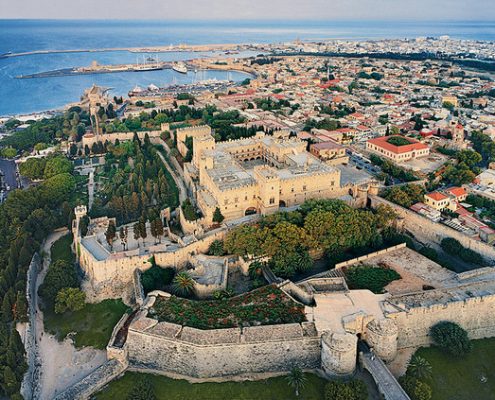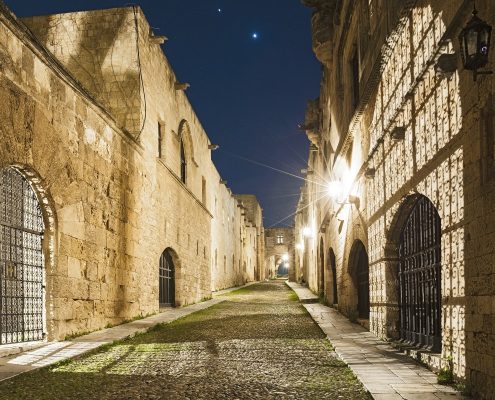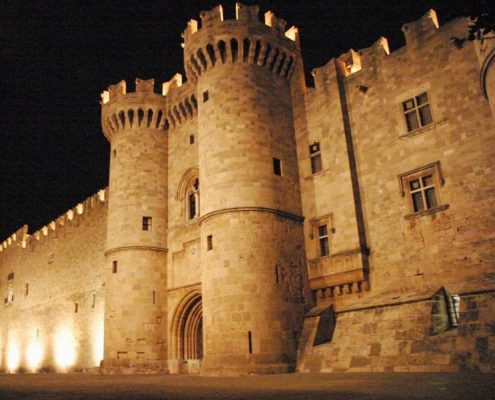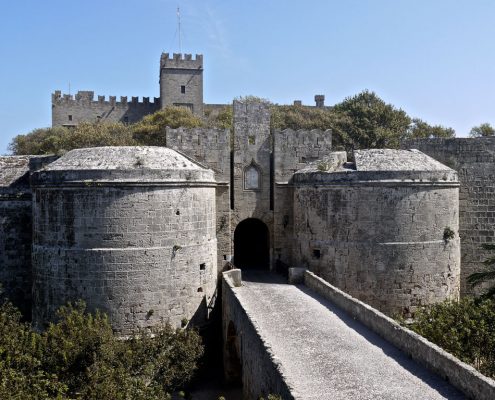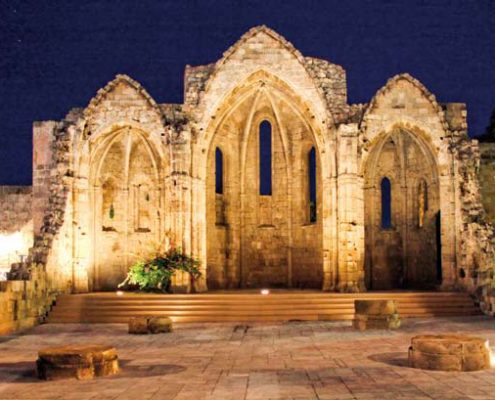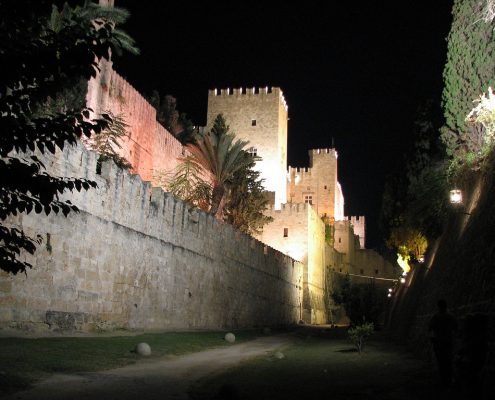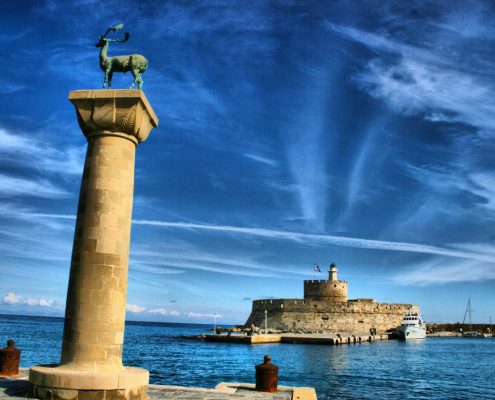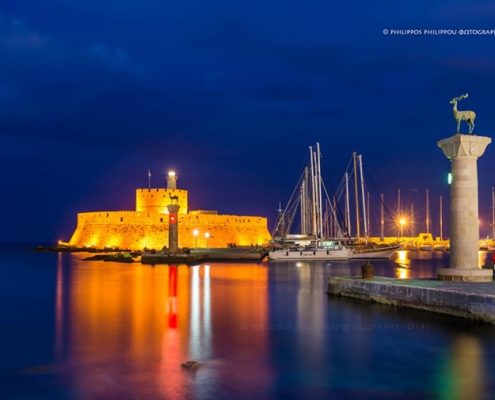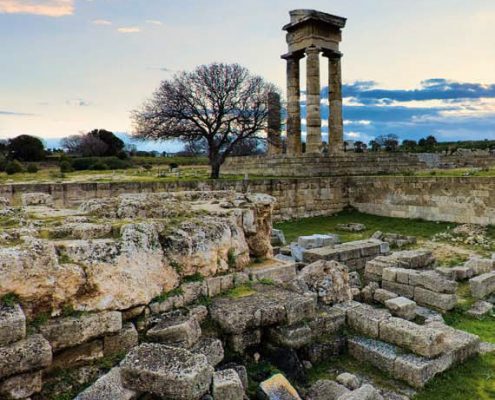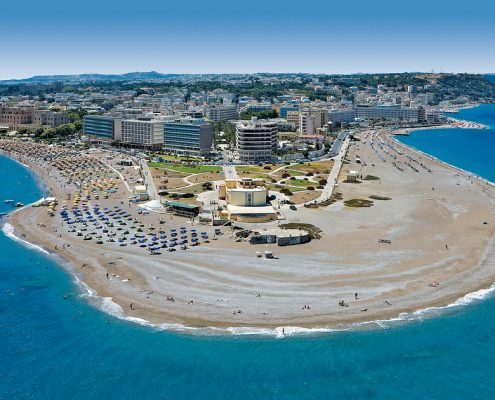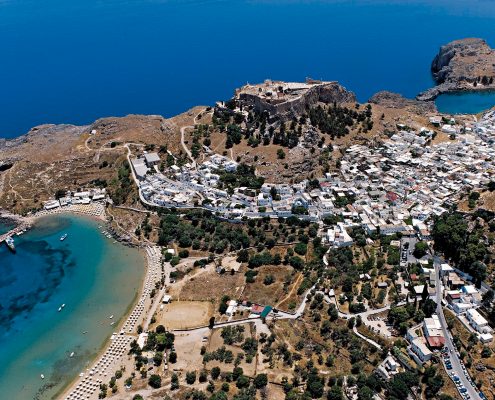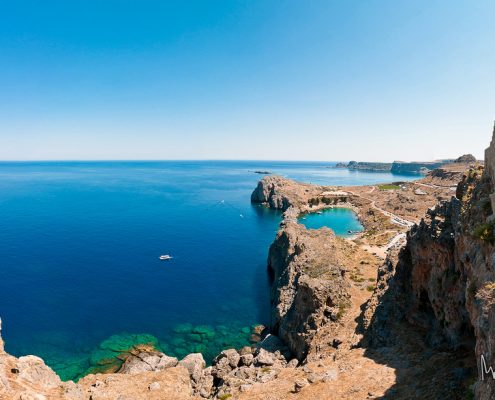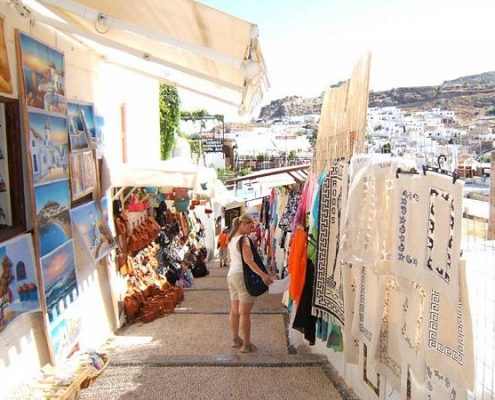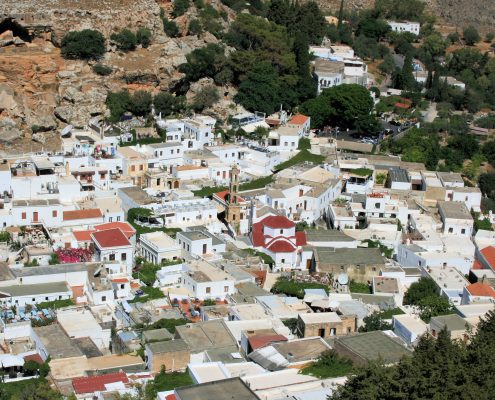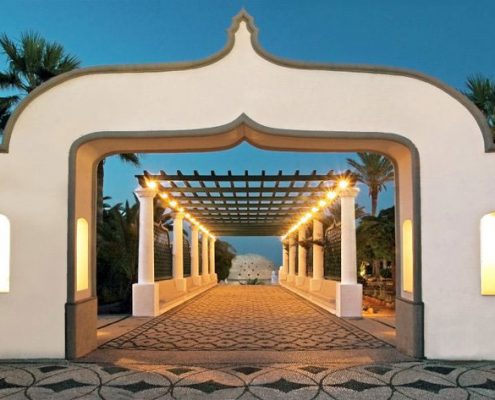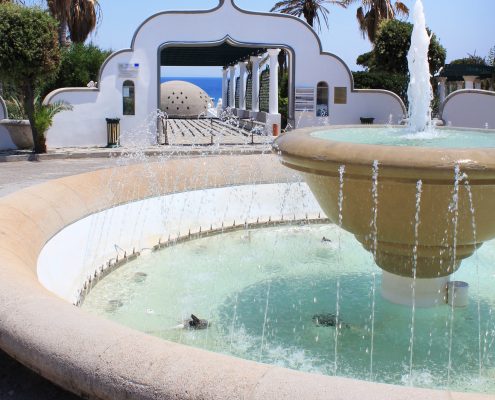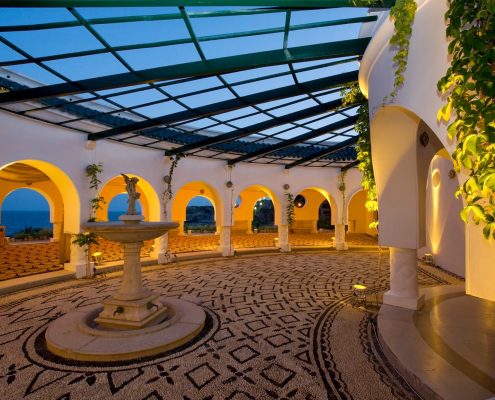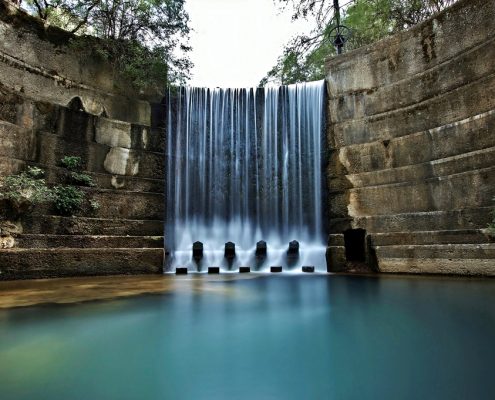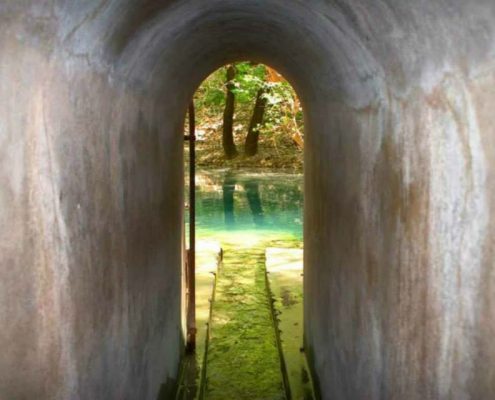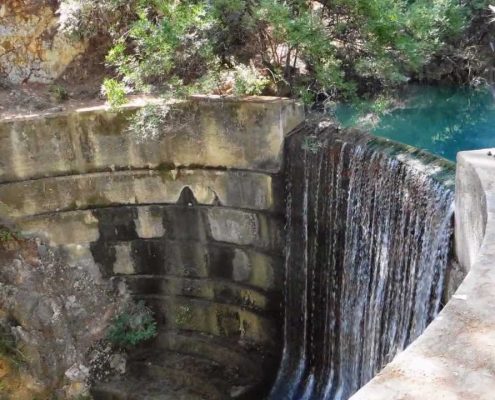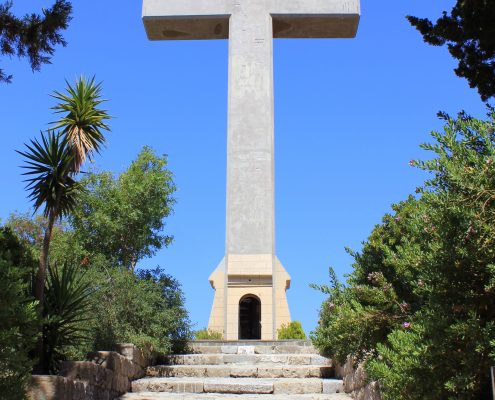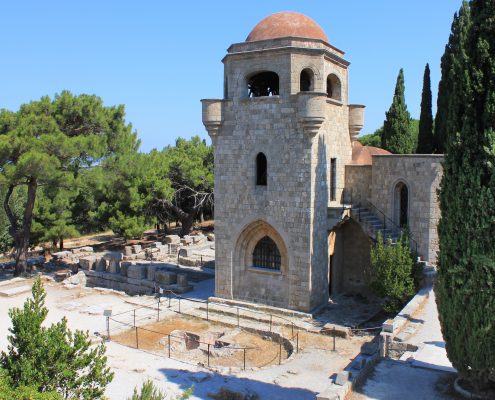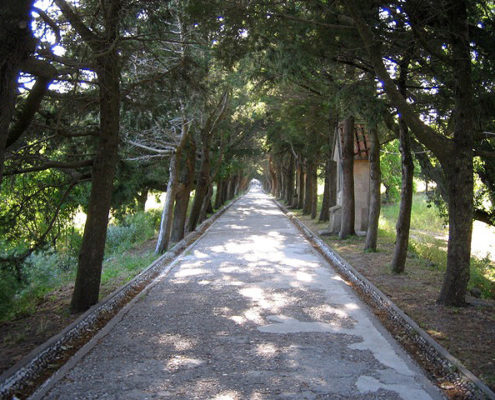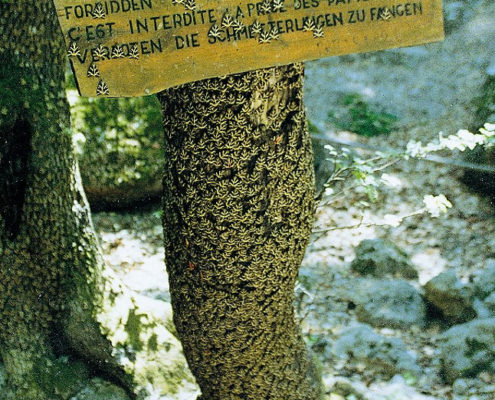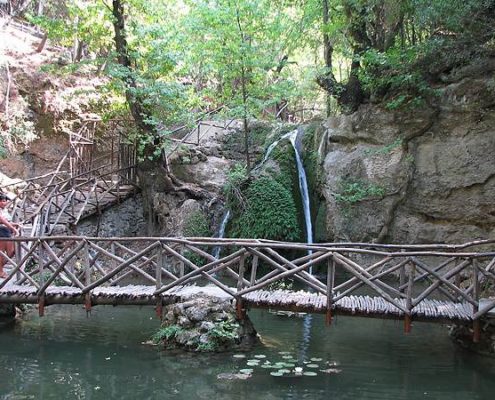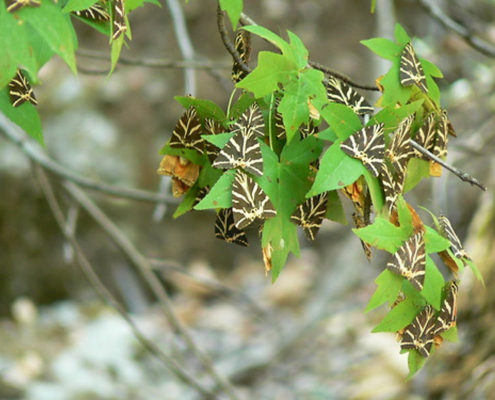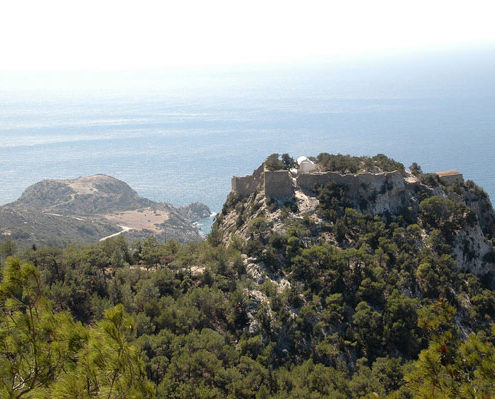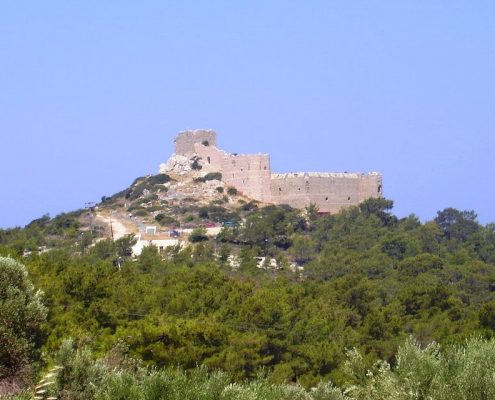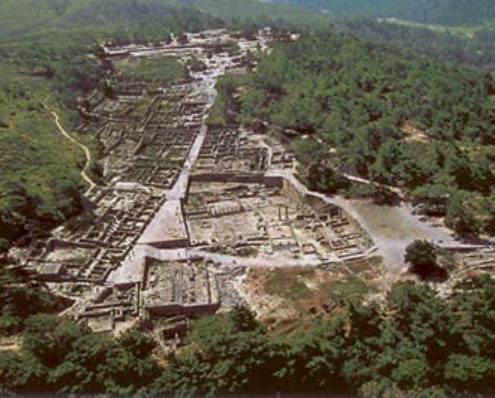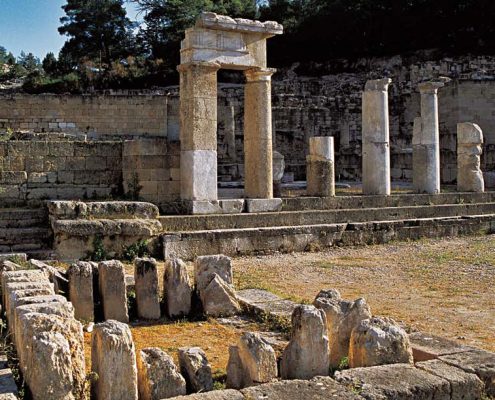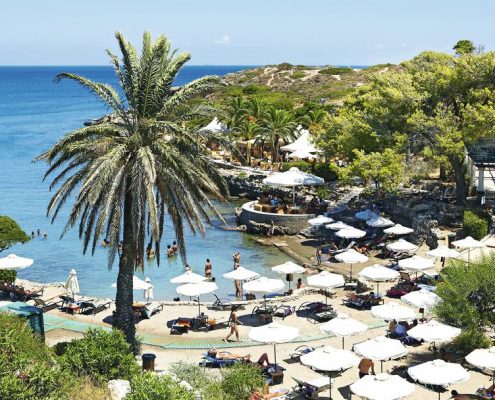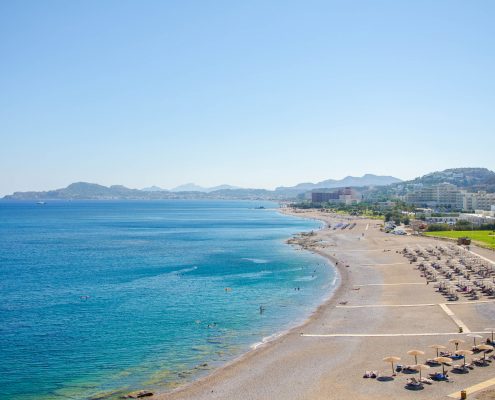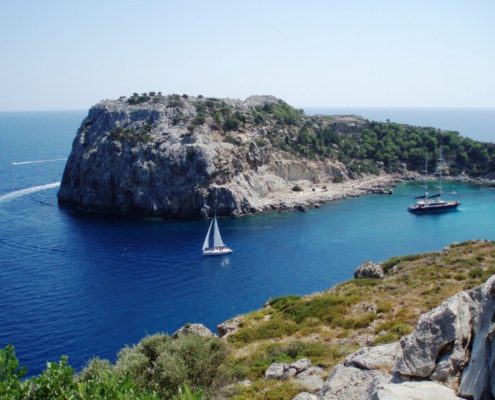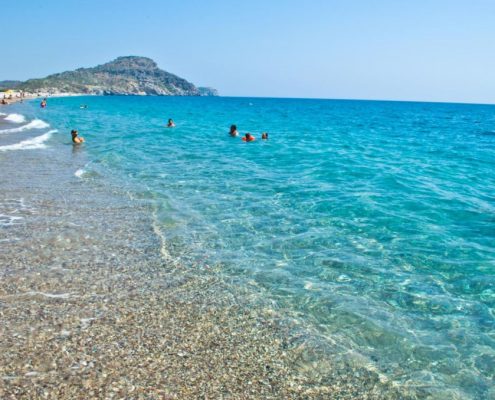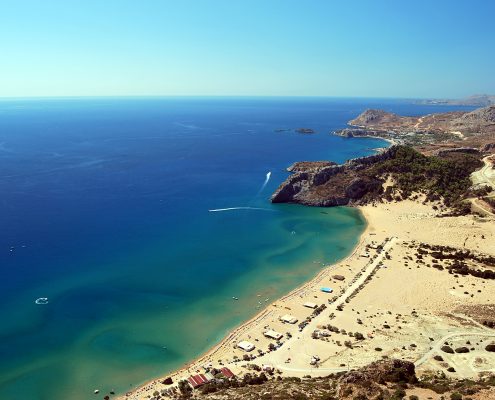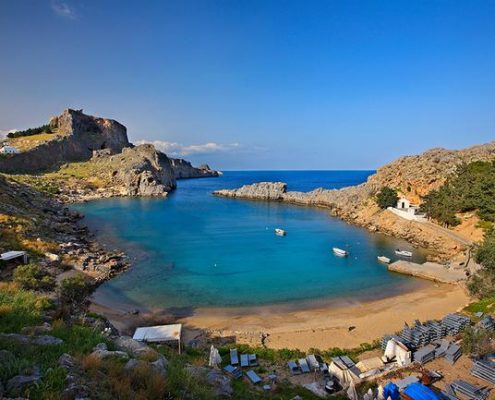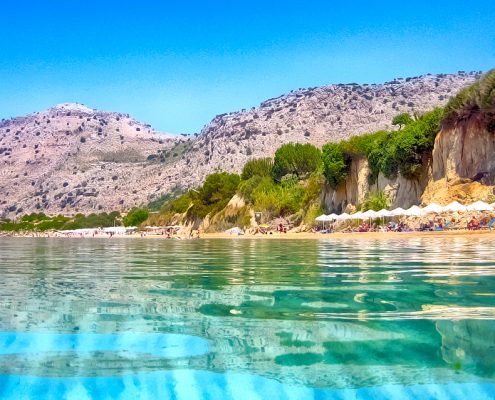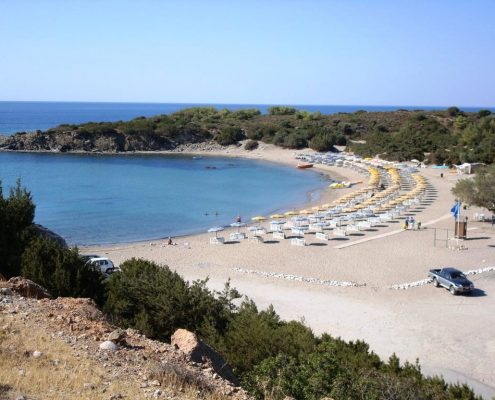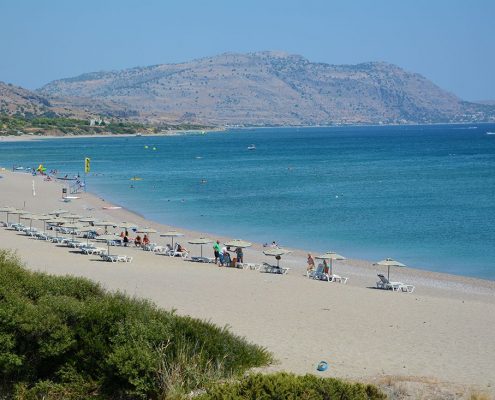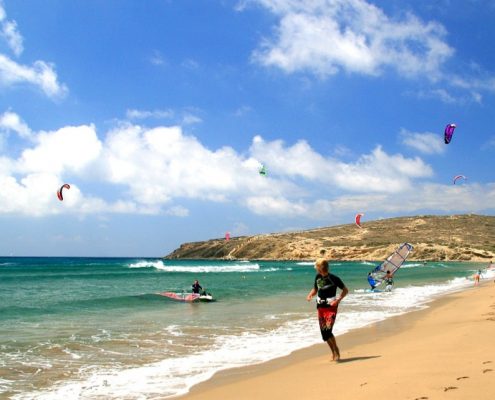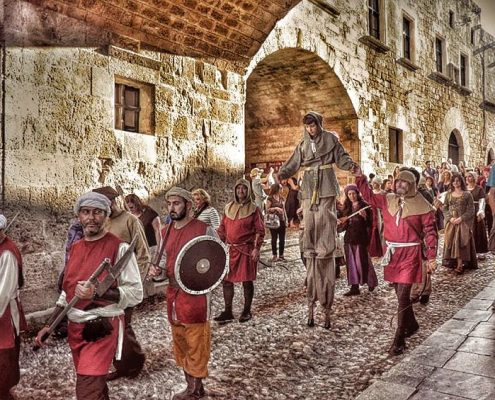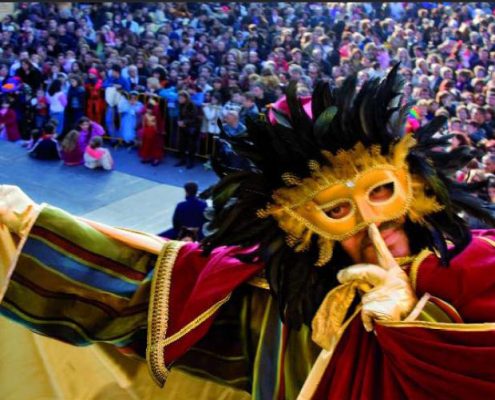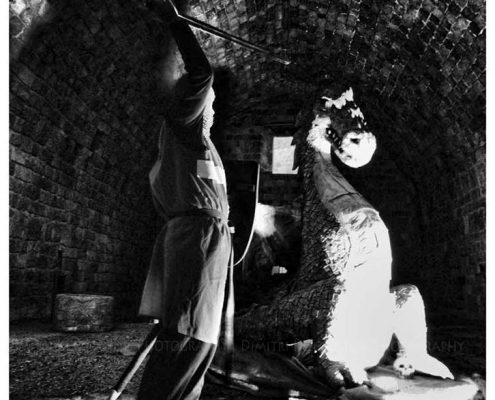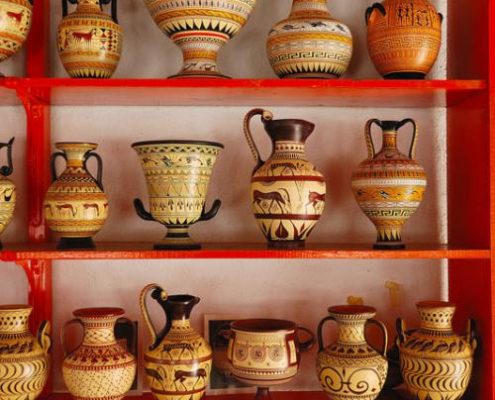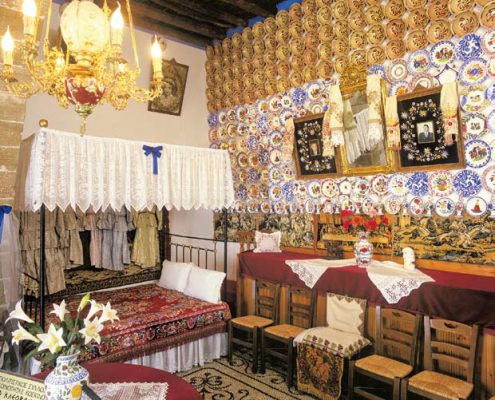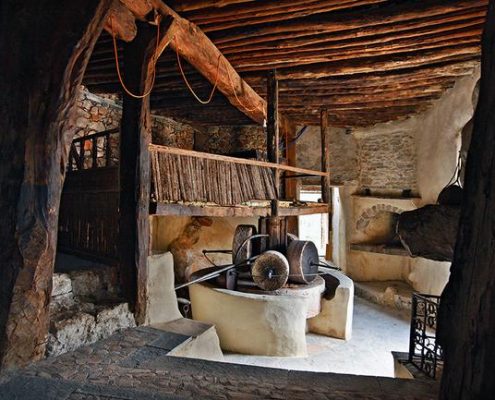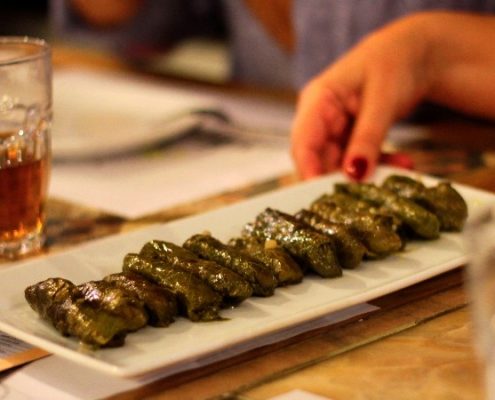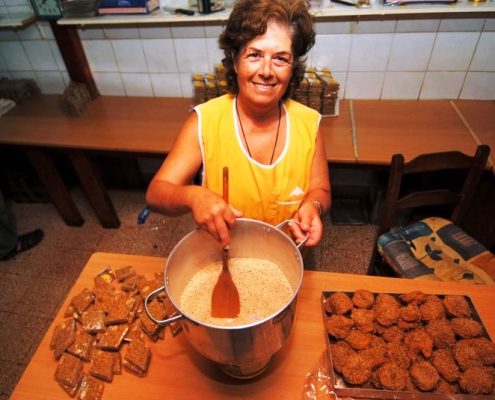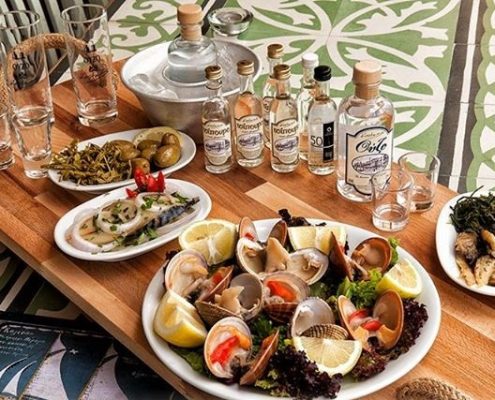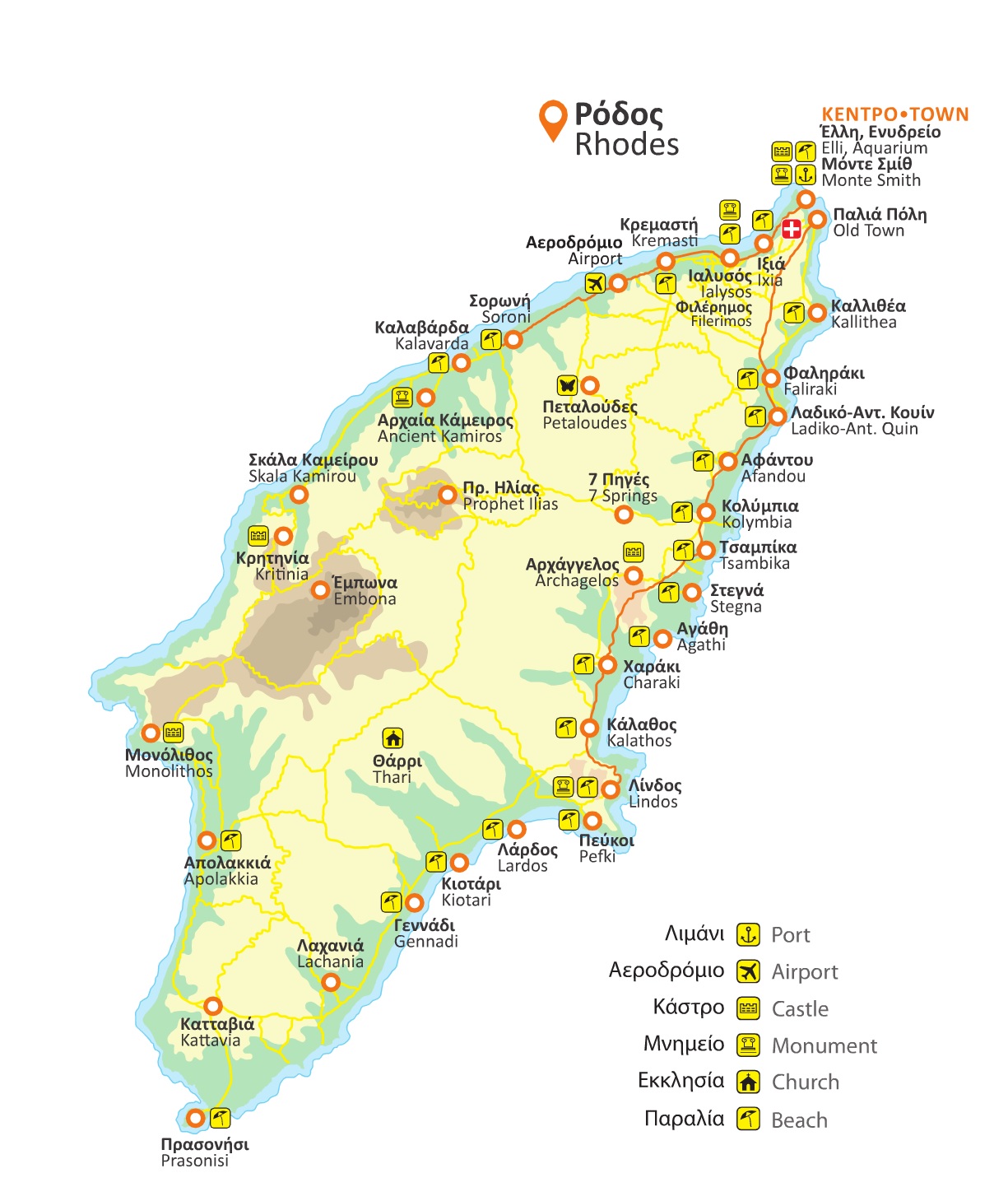
RHODES GUIDE: THE ISLAND OF THE KNIGHTS
The many names of Rhodes also reveal the multilateral character of the island: green, cosmopolitan, sunny with lacy coasts, and rich in tradition and history. From mythology until recent history, the island’s past is charming and mysterious: it is said that Apollo, the Sun god was absent when the twelve gods distributed the world. So, he asked for the “island that would emerge from the waves”. Thus, Rhodes has always a place in the sun’s heart, which sheds its light on this blessed island, and fills it with green, color, and creation.
HISTORY
The city
The city of Rhodes is located at the south end of the island that has the shape of a perfectly cut diamond. With the Old City in its heart, you will find there the center of commercial activity of the island, as well as many sights and opportunities for walking and sightseeing.
Its architecture is a combination of classical, Gothic, medieval and Arab influences, while the presence of the Italians is also evident in the town planning and the manufacture of the impressive buildings of the commercial center of the city, the said Mandraki. The port, the beacon of Saint Nicolas, the Aquarium, the Ancient Stadium with the temple of the Sun god, are some of the locations that will charm all visitors with their unique beauty.
A Museum of Neohellenic Art operates in the city, while in the Medieval City, the old Hospital of the Knights hosts nowadays the Archaeological Museum, where you will see great findings from ancient Kamiros, and mosaics of the Hellenistic period, as well as great value sculptures, such as Marine Venus. We should note that the Winged Victory (Nike) of Samothrace, which is exhibited in the Museum of the Louvre, and the Laocoon complex in the Museum of the Vatican, are two of the famous works that belong in the School of Rhodian Sculpture of the Hellenistic period.
The Colossus of Rhodes
One of the 7 Wonders of the Ancient World, the Colossus of Rhodes was a 33 m. high copper statue depicting the god of Sun, situated over the port of Rhodes and built by the famous sculptor Haris of Lindos. There are many legends regarding its exact position, its appearance as well as its fall destruction. It is said that it was almost as high as the Statue of Liberty, in New York and that it was meant to resemble Alexander the Great.
The Medieval City
A legend by itself, the Medieval City of Rhodes is the best preserved, inhabited medieval city of Europe and a Cultural Heritage Monument of UNESCO. It was divided in two sections: the first was the so-called Collachium, the high class sector where the Knights lived, divided in eight “Languages” (national, as well as administrative groups).
Τhis was the most prominent and prosperous part of the city, which included the Palace of the Grand Master, the accommodations of the Knights, the large temples of the order, Saint John of Collachium, and Virgin Mary of the Castle, and other significant installations.
The second area was named Bourg, the most low caste neighbourhood, where lay people and common soldiers lived. The wall of the Medieval City with the 13 bastions and the impressive trench was a pioneering example of fortification for its time, and was indeed able to push back hordes of enemies of all nationalities.
SIGHTS
Rhodes is an island that gradually reveals itself to the visitor, and calls them to revisit it in order to enjoy its many sights. In the center of the city, apart from the impressive Old City, the old Acropolis of Rhodes is still standing at the Monte Smith hill, where the temple of Apollo Pythian is located with a well preserved ancient stadium and a mable open conservatory.
You can also visit the impressive cemetary of Karakonero featuring burial complexes of the later Hellenistic period, as well as the Aquarium, a unique, atmospheric shelter of marine organisms, with seawater, on the edge of the island.
Kallithea Springs, Seven Springs, Archangelos
On the eastern side of the island, at a small distance from the city, you will find one of the most beautiful and famous sites of Rhodes, the Kallithea Springs. There, the Italian architectural eclecticism is evident in all its glory, in combination with the natural landscape and the crystal clear waters of the bay. A real pearl in the island’s chest.
A stop at Seven Springs, an oasis of greenery and coolness during the summer, will reveal the small waterfall. This impressive project was used for the supply of the Kolymbia village with water.
Further along the eastern side, you will find the castle of Archangelos, built during the Knight period, as well as the village itself, a traditional Rhodian “hive” full of activity and lively memories both in the interior decoration of the village’s houses as well as the preserving of the island’s customs.
Lindos, a pearl in the Aegean Sea
Nothing can prepare the visitor, for the stunning sight that they will face when they see the Acropolis of Lindos and the majestic settlement at a bend of the road. A breathtaking beauty that takes the viewer to the past, which suddenly doesn’t seem so remote.
Lindos was built by the Dorians, like the other two big cities of ancient Rhodes, Kamiros and Ialyssos. During the byzantine period, the acropolis of the city was transformed to a fortress, which was reinforced later by the Knights of the Order of Saint John. The temple of Athena Lindia, which is located in the castle, has its root in the geometric era, around the 9th century B.C. The ancient theater, at the slope of the hill, with a capacity of over 1,500 viewers, is also typical of the era.
Probably most beautiful view of the island is the view of the natural bay of Agios Pavlos (Saint Paul) from the hill of the Acropolis of Lindos. A small port with crystal clear turquoise and green waters that seems like an oasis from the distance of 116 m. between the castle and the sea. It is said that Apostle Paul disembarked there during his journey.
The west side, Filerimos
However, it is not only the eastern side of the island that is rich in historic and archaeological beauties. Near the city of Rhodes, on the west side, you will find the monastery of the hill of Filerimos, where during the Medieval era monks used to live. In the yard of the monastery one can see the ruins of the ancient city of Ialyssos, while the “Path of Martyrdom” is an impressive paved path of Italian construction, with representations from the “pathos” of Christ, ending at the impressive Crucifixion: 16 meters high, it is made of reinforced concrete, and dominates over the whole western side of the island.
The necropolis of Kamiros
A particularly significant location for the island history is the necropolis of ancient Kamiros. Since the archaic era, Kamiros was an important commercial center, while during the prehistoric period the city worshipped the “Mylantian gods”, who taught people how to grind flour and knead bread. The city was developed (as were Lindos and Ialyssos) by the Dorians, while it began decaying when the city of Rhodes was built. The earthquake of 142 B.C. destroyed the city, and it came to light again with an archaeological excavation of 1859. The entire archaeological settlement is preserved in extremely good condition, and the town planning system, the water supply measures, the reservoir, and the Arcade are really impressive.
Valley of the Butterflies
The Valley of the Butterflies is another one of the landmarks of the island: the “zitia” tree, which is found only in limited Mediterranean sites, hosts millions of butterflies that peacefully hang in the shadowy wet paths it creates with the brook, which sometimes is transformed to lakes and small cataracts. Butterflies are gathered in the valley during summer months, while disturbing them is strictly inhibited, as this disrupts their reproductive procedure.
The castles of Kritinia and Monolithos
As the visitor approaches the other side of Rhodes, the Castle of Kritinia, a very powerful fortress overlooking Alimia and Chalki emerges impressively in the horizon. In 1480 the Ottomans sieged it, but they didn’t manage to conquer it. It is very well preserved, while the view is magestic. At its entrance you can see the coats of arms of the Grand Master D’Amboise (1503-1512) and the Grand Master Origny (1467-1476), the ruins of the catholic church of Saint Paul, as well as more recent buildings, since the castle was used by the Venetians as a dockyard. here, you will enjoy one of the most beautiful sunsets of the island.
A few kilometers away, another unassailable fortress dominates the rock: 15th century’s Castle of the Monolith. It is one of the most powerful fortresses of Rhodes. It is 237m. high, and has an impressive view towards the sea, while during classical times a “firetower” trasmitted signals to the city by fires.. This castle remained unassailed even though it had been attacked many times by aspiring conquerors. Continue your tour on the island with a walk to Profitis Ilias (Prophet Elijah), the tree-lined mountain that Italian Commander De Vecchi selected in order to build his summer residence.
BEACHES
Rhodes is considered α heaven on earth with lacy coasts and crystal clear, majestic waters. Endless coastlines with beaches for all tastes are harmonically combined with hidden small bays, picturesque ports, and moon-like rocky beaches. Even in the center of the city, Elli beach offers cosmopolitan atmosphere and all the comforts of organized beaches, while the Aquarium, with its double beauty, peacefully lies at the edge of the island: on the one side the sea is calm and peaceful, the beach is organized and the view of the ships traveling to remote destinations is dreamy, while on the other side the sea is stormy, playful and green like the Caribbean.
Kallithea
Kallithea bay is a very beautiful choice, near the city, organized with umbrellas and cafeteria, while at the Thermal Spa there are often temporary and permanent exhibitions (please note that there is a low priced entrance ticket). In the same area, between the sand and the pine trees, you will discover three small, hidden bays with exotic rocks and warm water.
Faliraki and Antony Quinn
Just a few kilometers away you will find the famous Faliraki, an endless heavenly sandy beach, which is the epitome of organized, stunning beaches. There are several beach bars, tourist restaurants and taverns here, while the area is also known for its intense nightlife.
In Faliraki you can visit the nudists cove, Ladiko bay, as well as the famous beach of Antony Quinn: A high overgrown rock that leads to a small bay of unique beauty with pebbles, crystal clear waters and one of the nicer and more exhiting seabeds of Rhodes!
Afandou
If you like a pebbled beach, the endless Afandou beach (and Traganou cave on its edge) are perfect for you. Only a few spots are organized here, and one can enjoy a relaxed, lonely swim with a view to the open horizon and endless kilometers of beach to the right and the left until the hill of Tsambika: soft sand hills, with warm, shallow, turquoise waters emerge, creating an exotic scenery. This beach is also organized in points, with canteens and water sports.
Lindos and South Rhodes
Continuing your course to the east of the island, you will find the beautiful Stegna bay, with a lot of traditional taverns, as well as Vlicha, a quiet, family friendly, sandy beach, until you reach Glistra cove, with the cedar trees that reach the sea.
At a small distance from Vlicha lies Lindos, with its tiny, picturesque beach in front of the traditional settlement, as well as the charming natural port of Agios Pavlos (Saint Paul), a taste of the endless blue color of the Aegean Sea. A dip in its crystal clear waters is a unique experience that you should not miss.
However, the majestic coastline of the island doesn’t stop there. Small village Pefki with its magical sand, and Kiotari are two of the nicer beaches of the island, while Gennadi, even souther, will charm you with its red and green pebbles and its unique tranquility: the absolute experience of the Greek summer. Having approached the southest end of the island, do not miss the chance to visit Prasonisi, the far south point of the island, a peninsula of exceptional beauty: on its one side, the sea is deap and peaceful, while on the opposite, the waves rise provocatively, attracting an international community of extreme sea sport lovers. An impressive phenomenon of extraordinary beauty even during winter months.
TRADITION
The Dodecanese islands have a rich tradition and folk culture that has been enforced and developed over time and conquerors. Ancient Greek, Byzantine, and Oriental details are interconnected in the traditions of the islands. Rhodes is a cosmopolitan island that has adopted to a large extent the modern way of life, but has managed at the same time to maintain the arts, the traditions and the customs of the past, especially in the villages, and with emphasis on the big religious celebrations.
The utilitarian as well as decorative art of ceramic making flourished here and created the famous Rhodian painted ceramic plates. Another characteristic was the architecture of folk houses, with “pataros”, a high-rise bed, the elevated roofs and the wooden railings. The textile industry also flourished here, with the technicians of the loom making embroideries and textiles of incomparable technique and beauty, while the excellent wines of Rhodes have been very famous, already since ancient times.
FLAVORS
Rhodes is famous for its traditional kitchen, which is based on natural ingredients abundantly offered by the earth and the sea of Mare Nostrum, the Mediterranean. As an authentic crossroad of civilizations, Rhodes has assimilated in its cuisine elements from the East and the West, and has managed to create dishes of great nutritional value, as well as high gastronomy.
The island’s cuisine is based on local meat, such as goat and lamb, as well as seafood. Here you can try all kinds of shellfish, from oysters, sea urchins and limpets to razor shells and species unique to the Mediterranean.
“Melekouni”, the traditional sweet of weddings, with pure honey and sesame, is one of the most widespread and tasty sweets of the island, while “xerotigana” and “diples” are still prepared at the traditional bakeries of the island.
The vines of Rhodes produce high quality wine and essenses, and many small producers, along with the two main wineries of the island, contribute to the promotion and exploitation of this local treasure and produce excellent wines, which have been repeatedly awarded in international exhibitions.
TIPS
Dedicate a day to the explore the Medieval City with the bastions, the museums and the unassailable trench, and discover, besides the colofrul and busy commercial streets, the deserted alleys in order to experience the unique atmosphere of the best preserved medieval city of Europe.
Visit the Contemporary Art Museum, at 100 Chourmadies area, which includes typical works of the most important representatives of the Greek artistic movement of the 20th century.
Don’t miss the opportunity to participate in one of the many religious festivals of the island, such as the festival of Virgin Mary on August 15th or the Strawberry, Souma and Honey Fairs.
Look out for the events of the Medieval Festival, like the Magical Moon of Lindos and the Feasts of the Castles, and live as Knights for a while.

